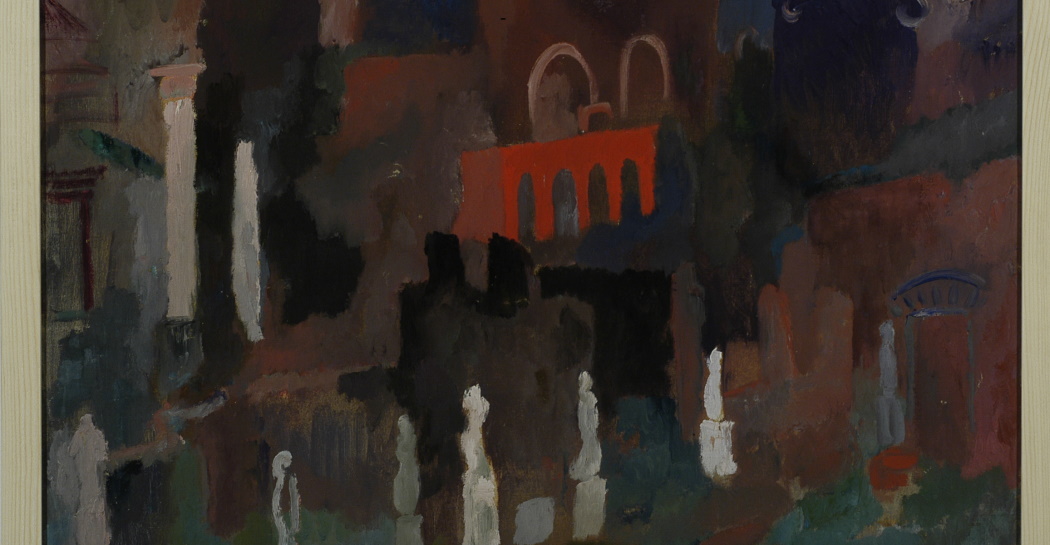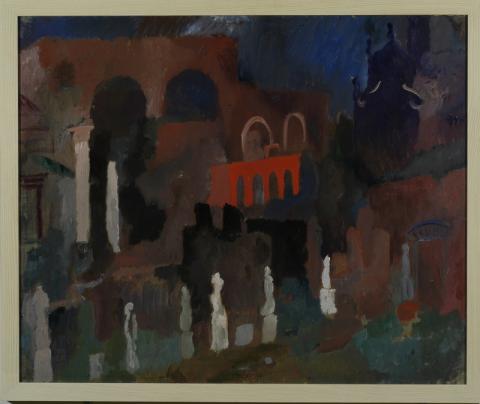The Artwork of the Month of the Roman School Museum - December 2022
CARLO LEVI
Paesaggio romano con archi in rosso, 1931,
oil on canvas, 51x61.5 cm;
on loan from the Carlo levi Foundation, Rome

In a landscape dominated for the most part by dark colours and the dense presence of silhouettes evoking ancient buildings and remains, among columns, statues and arches, the volume of a four-arched structure stands out in the centre, highlighted by a bright red, almost coral tone. Despite the deliberately rarefied atmosphere, in which the realistic representation of the site is certainly not a priority, the painting nevertheless allows one to recognise a precise area of the Roman Forum, that of the Basilica of Maxentius, at the top left with its large arches, and the structures adjacent to it. On the right, the black, nocturnal silhouette of the Baroque church of Santa Francesca Romana stands out, and finally, in the lower part of the composition, the statues of the House of the Vestal Virgins emerge, sketched in white. Levi had been in the capital for the first time in 1922 when he witnessed the rise of the fascist regime with the March on Rome. The Roman Landscape with Arches in Red was painted during his second stay in Rome, in 1931. At that time, the artist arrived in Rome after signing a contract with Cines for the production of some screenplays and set designs for the cinema. In the same year he exhibited his works at two important events, the first Quadriennale d'arte at Palazzo delle Esposizioni and a group exhibition at the Galleria di Roma. In this landscape, the artist renders a transformed vision of reality, where the ancient ruins become ghosts of past splendours, but in which the inclusion of the volume in red, focusing attention, takes on a symbolic and disturbing value, like a foreboding alarm of future ruins or an open wound within a context of dark tones and evanescent air. Both in terms of poetic intent and pictorial technique, the painting is influenced by the frequentation of the artists of the Roman School, in particular Scipione and the Mafai couple. The proximity to Mario Mafai is artistically recognisable in the shaded colour drafts and in the ill-defined volumes of the sign.
CARLO LEVI (Turin, 1902 - Rome, 1975)
Carlo Levi, one of the leading figures of 20th century Italian art, stands out for the versatility of his intellectual commitment, divided between painting, writing and anti-fascist activity. He is internationally known for his novel Christ Stopped at Eboli, which made him one of the major spokesmen of the southern question after World War II.
He was born into a wealthy Jewish family of the Turin bourgeoisie. He graduated in medicine at the University of Turin and during his university years he collaborated with the magazine 'La Rivoluzione Liberale' and attended Felice Casorati's painting school, around which the artistic avant-garde in Turin gravitated. Inserted in this context, the young Levi got to know personalities who were important for his growth, at the same time pictorial and literary. Although he started a practice as an assistant after graduating, he never practised as a doctor, definitely preferring painting and journalism. At the end of 1928, he took part in the so-called Six Painters of Turin painting movement, which led him to exhibit in various cities in Italy and abroad. Over the years, his painting, initiated by the tradition learned with Casorati, evolved first with the influences of the Parisian environment he frequented and then with his closeness to the artists of the Roman School. In this context, he exhibited at the I Quadriennale nazionale d'arte in Rome in 1931. Levi, by cultural and political choice, always considered painting as an expression of freedom, as opposed to the rhetoric of official art. His anti-fascist positions led to his first arrest in 1934, which was followed by a second arrest in May 1935 and a sentence of confinement in the Lucanian town of Grassano. He was subsequently transferred to the small town of Aliano, in the province of Matera. From this experience he drew inspiration for the events narrated in his novel Christ Stopped at Eboli, published by Einaudi in 1945. The resonance that the novel would have overshadowed his own activity as a painter, but it can be said that the evolution of Levi's painting was influenced precisely by that stay in Lucania, becoming more rigorous and maturing into a personal realism. In 1936, the fascist regime granted him a pardon and Levi moved to France for a few years, where he continued his political activity. On his return to Italy in 1943, he joined the Partito d'Azione. He found refuge in Florence, at Eugenio Montale's home, where he stayed until 1944. It was here that he met Umberto Saba, his future father-in-law. After the war, Levi continued to work as a journalist, as a painter, with numerous participations in national events and at the Venice Biennale, and as a writer, with other novels of great interest (L'orologio, Le parole sono pietre, Il futuro ha un cuore antico, Tutto il miele è finito). In 1961, he painted Lucania '61, a large canvas measuring 18.50 x 3.20 m that he dedicated to the memory of Rocco Scotellaro, a poet from Basilicata who was a friend of his, now exhibited in the National Museum of Medieval and Modern Art of Basilicata in Matera, in Palazzo Lanfranchi. In the 1960s, Levi was twice elected Senator of the Republic, as an independent of the Communist Party.
Since the second half of the 1970s, the Foundation of the same name, established by the will of the artist himself, has been dedicated to promoting knowledge of the figure of Carlo Levi by organising conferences, exhibitions and publications.
Back to the section > The Artwork of the Month of The Museo della Scuola Romana












































